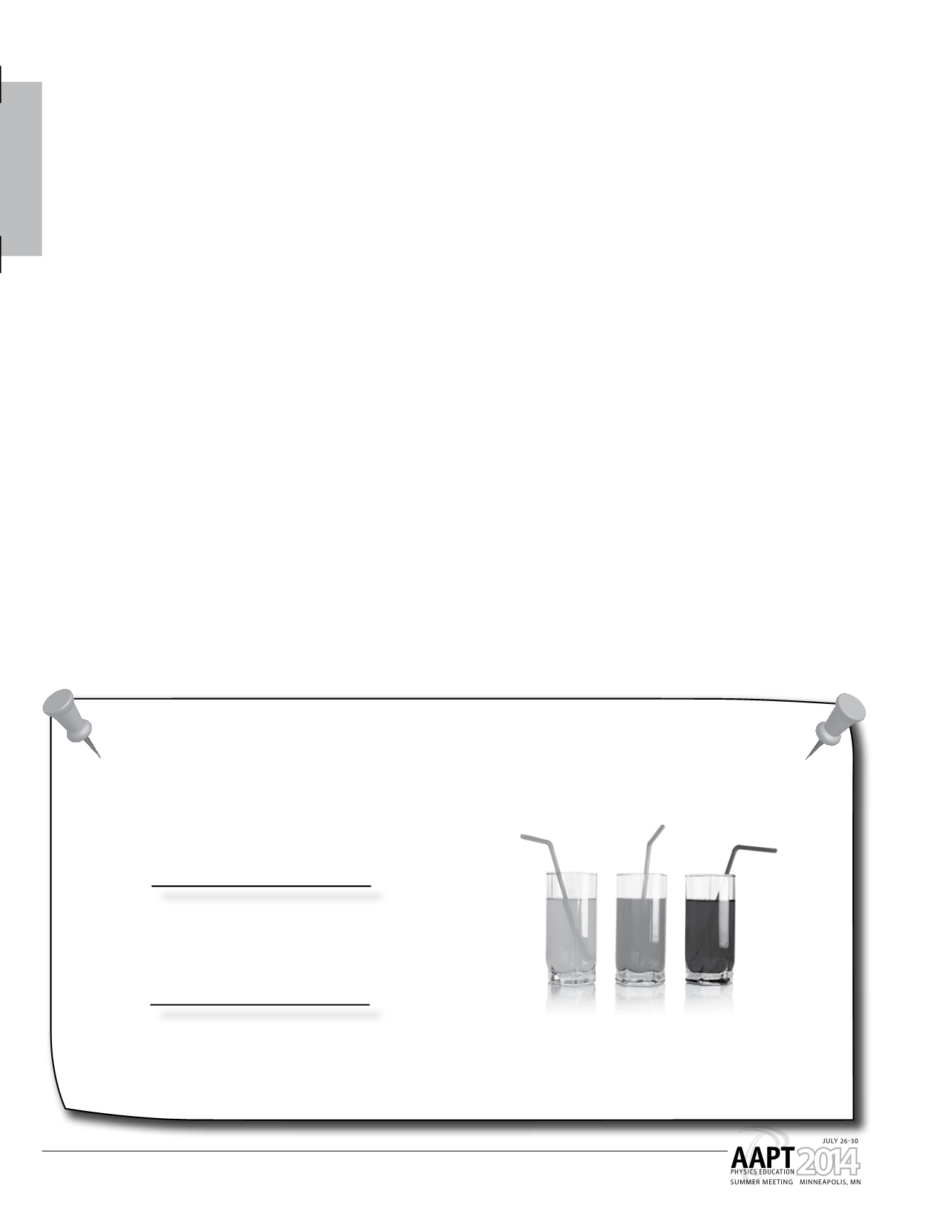
Monday morning
54
add content to the template and can even work with the students on the
report if they need help. No documents are emailed back and forth. After
the due date, the instructor makes the template “read only” and provides
feedback to the group on their lab template. To ensure effective collabo-
ration, each student fills out a Google Form evaluating the quality and
quantity of work done by group members. A student’s lab report grade is a
combination of the lab points earned and the peer grade.
AI03:
8:50-9 a.m. Hybrid Visual-tutorial Instruction Model to
Learn the Concept of Electric Charge
Contributed – Maria D. Gonzalez, Tecnologico de Juarez, Valle de Batopilas
11429 Ciudad, Juarez, Ch 31310, Mexico;
Juan Luna-Gonzalez, Jesus Estrada-Cabral, Luis L. Alfaro-Avena, Oscar
Ruiz, University of Juarez
The University of Juarez and the University of Texas at El Paso have devel-
oped a hybrid-instruction instructional model to combine lab activities
and a tutorial-based inquiry through the use of a video. Students from the
introductory physical sciences courses can construct the concept of electric
charge. Data were collected through a post-test, a pre-test and a conven-
tional lab designed in the same context of the corresponding learning
topics. Students are exposed to a 20-min video previously to the lab activi-
ties. This video is available for students thought the whole lab. Students
have the option to watch any section of the video as many times as they
need it. Results show that students’ questions related to lab procedures and
conceptual content are reduced. Finally, we will present the corresponding
learning gains and the possible mechanics-electricity transfer of knowledge
of both, treatment and control groups.
AI04:
9-9:10 a.m. Measuring Centripetal Acceleration with a
Liquid Accelerometer
Contributed – D. G. Sumith P. Doluweera, Georgia State University, Atlanta,
GA 30303;
Brian D. Thoms, Olesya I Olesya, Maria Rusert, Carola Butler, Joshua Von
Korff, Georgia State University
As a comprehensive PhysTEC site, GSU has undertaken a reform of
calculus-based introductory physics. As part of this reform, a new experi-
ment was developed to enhance students’ conceptual understanding of
centripetal acceleration. The experiment was done before introducing
forces and just after discussing acceleration in two dimensions. The behav-
ior of liquid accelerometer under linear acceleration was explained and
demonstrated to students without discussing dynamics. Then they were
asked to use the liquid accelerometer to observe the direction of centrip-
etal acceleration and qualitative changes in magnitude of the centripetal
acceleration with radius and angular speed. The experiment was designed
as a guided inquiry. Students used the equation for liquid accelerometer to
measure centripetal acceleration at a point in a rotating platform and tested
out the theory learned in class as a hypothesis. The experiment and student
responses are discussed.
AI05:
9:10-09:20 a.m. Measuring the Acceleration Due to
Gravity
Contributed – Thomas B. Greenslade, Kenyon College, Department of Phys-
ics, Gambier, OH 43022;
Racing is the sport of kings, but finding the value of the acceleration due
to gravity is the sport of physics teachers. I once laid out a schedule of
first-semester labs in which each one resulted in a value of “g”. Fortunately,
cooler heads prevailed. In this talk I will discuss a number of ways to mea-
sure this value that have been used in the past.
AI06:
9:20-9:30 a.m. A Single Drop Milikan’s Experiment
Contributed – Dag Hanstorp, University of Gothenburg, Kemivägen 9 Gothen-
burg, SE 412 96 Sweden;
Oscar Isaksson, Magnus Karlsteen, Chalmers University of Technology
Mats Rostedt, University of Gothenburg
I will present an experimental set-up in which optical levitation is com-
bined with Millikan’s classical oil drop experiment. An oil drop trapped in
a focused vertically aligned laser beam is made to oscillate by applying an
alternating electric field. The position of the drop is observed by imaging
scattered laser light onto a screen and the radius of the drop is measured by
detecting the diffraction pattern produced when illuminated with a hori-
zontally aligned He-Ne laser beam. The number of excess charges on the
drop can be measured, and number of charges can be reduced by exposing
it to a radioactive source. The goal of the project is to design a system that
can be used to demonstrate several fundamental physical phenomena
using the bare eye as the only detector. The experiment can be used for
classroom demonstrations or as a laboratory exercise on the college level.
Poster Session 2
5–6:30 p.m.
Tuesday, July 29
Coffman Union ground floor
Poster Session 1
8:30–10 p.m.
Monday, July 28
Coffman Union ground floor
AAPT Poster Sessions
with Refreshments
Post Deadline Posters
1–2:30 p.m.
Wednesday, July 30
Coffman Union ground floor


